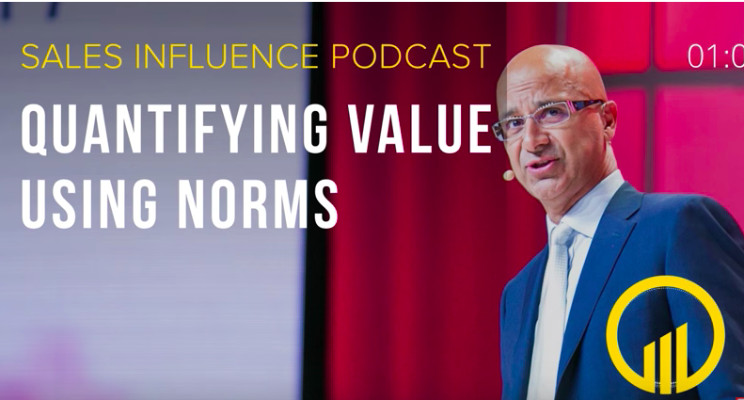
Using Norms To Quantify Value
Today I was doing a podcast interview, and one of the topics that kept coming up over and over again is, "Victor, how do you quantify value? How do you go about creating enough value that the customer goes, 'Oh, I see why I should buy your product or service.'"?
Because it's never about price.
If I can show you the value of what my product or service can do for you, whether it's B2C or B2B, and I can quantify that value, the customer's more likely to say "yes" than "no."
So in order to quantify value, we have to take a step back in time a little bit and introduce you to a gentleman, Mack Hanan who the wrote the book, Consultative Selling. In the '70s and the '80s, Mack Hanan was well-known, and even into the '90s, people really studied Mack Hanan. In fact, many of the sales books today are still rooted in many of the things that Mack Hanan taught. One of the things I learned from reading that book is all about knowing your numbers. I love the formula he created; it's really helped me when it comes to quantifying value when I talk to customers.
To start:
You have to know the industry norm is. Let's say that I'm selling sales training, and I need to be able to convince the customers to buy my services. And so one of the questions I often get is, "Victor, how can you help us?"
So, I know that at the end of the day, it's all about the close rate.
I use that fact and tell customers, "Mr. Customer, did you know that in the pharmaceutical industry the industry norm, is 35% close rate? In other words, your peers, companies you compete with, companies similar to you, they're closing 35% of their deals. Based on what I've seen, companies I've worked with, the average close rate when I'm done working with you is about 45%." Now, I can quantify my value because my close rate with customers I've worked with in the past is 45%. I can help them close 10% more deals on average.
Now for the important part: I can quantify that number, take the average order size, multiply that by the close rate, and figure out how much more money I can make this company.
I can quantify my value because I know the close rates.
Now, what if you believe you can help them close 45% of the deals within that market segment, and they say they're closing 60%'"? Well, at that point they don't need my help, and that's okay. But, not only do 8/10 companies don't know what their close rate is, many of these companies are not exceeding the norms or the average close rates, which is why they need help.
So how could you use this? Let's say you're selling a service. You're selling software as a service and you're going in to talk to a company who's in the payment industry. And so one of the things you wanna do is figure out, what is the industry norm when it comes to paying for these type of services? What's the typical cost that you're paying? What's the industry norm?
For example, let's say the industry norm for a typical platform subscription rate is $500/ month. For this amount of applications, features, and functionalities, most companies pay, is $500.
Now you come in there and you say, "Mr. Customer, what are you paying?" Now, the customer may not even know what the industry norm is. For all I know, they're paying $1000, and I know that the industry norm is $500, which means they're overpaying. And then what if I say, "Mr. Customer, our number for this same platform, is $400, which means I can save you $600." Again, you can now begin to multiply that out by the number of subscriptions they have, and you can quantify the savings almost immediately.
The power to know these three numbers can help customers realize what they're losing.
What is the industry norm?
Your number: the average % benefit, the cost difference.
Their number - Their close rates, their costs, etc.
(Don't be surprised if they don't have the answer. And in fact, if they don't have the answer, that is an opportunity for you to position yourself as an expert and help them achieve the level of success they need reach).
Quantify Your Full Value to the Customer with Value Centric Selling
Create Credibility and a Trusted Reputation in Your Industry with Closing The Credibility Gap
Create a Mastery Level Sales Process From Prospecting To Close
Only on Sales Mastery Academy
Get Your 3 Month Access Pass to over 320 Sales Training Videos for $99
SGWS Indiana Facilities Manager
6yHow could I translate this info, in any part, to a B to C single item purchase? Any ideas?